–The music is everything. Can we hear it?–
Erda and Rabbit Lane lie in the low lands of the Tooele valley. Still, we are high enough to see the silvery ribbon of the Great Salt Lake lining the horizon. The northerly breeze often brings with it the smell of salt in the air as it brushes over the enormous lake, transporting me through the darkness to days of my youth spent beach combing and sailing near New Jersey’s Sandy Hook, looking across the bay to the iconic twin towers that exist now only in memory and in mourning, and in old photographs.
Each day brings its own song. Yesterday’s song has faded into memory. It can be recalled but vaguely. Attempts to retrieve it are vain. So, let the old song go. Find today’s song and rejoice in its tune, whether it be happy or sad, ebullient or contemplative.
We are influenced by what we see and hear, smell and taste and feel, by what is going on around us. Honking taxis. Smelly steam from subway manholes. Trains rattling on overhead tracks. Rain-wet concrete under foot. A hot pretzel around the corner. Deep green alfalfa with small, purple blooms. Freshly cut hay drying in long lines down the length of the field, waiting to be bailed. Cows bellowing as the farmer forks out their evening meal. A vase of summer sunflowers. A glass of fresh-squeezed orange juice. Children laughing at the playground. The words I love you. The music is everything. Can we hear it?
* * *
Russian Olive trees, despised by farmers and ranchers, grow wild and tangled along portions of Rabbit Lane’s ditch, invading the pasture and sucking the water. Their hard thorns can grow to a length of two inches and snag the shirt or hair of any careless passerby. One would never think of climbing a Russian Olive. From a short distance, they resemble the true olive trees of the Mediterranean. Their leaves grow narrow and long, in color a powdery blue-green-gray. Late Spring produces strands of tiny yellow flowers that fill the air with a sweet pungency, pleasant but at times overpowering. In late Fall, millions of dwarf olive berries fall from the trees and litter the roads. The pits, tiny striped footballs, can be drilled and strung for necklaces.
Fields of wheat, barley, and alfalfa hay sprawl adjacent to Rabbit Lane. Farmers irrigate these fields with great wheel lines. A wheel line consists of six-foot-high metal wheels with flat rims and spindly spokes connected to 40-foot lengths of four-inch-diameter aluminum pipe. The resulting line can be half-a-mile long. Sprinkler heads rise periodically from the pipes, connected by brass fittings. Drug addicts have at times broken the sprinkler risers off the pipes to harvest the brass fittings, scrapping them for cash. The thieves are usually caught and prosecuted, spending years in prison while the farmer has suffered tens of thousands of dollars in damage to his sprinklers while being unable to irrigate his fields.
Each pipe segment is centered at the wheel, with 20-foot lengths of pipe welded to each side of the wheel, forming an axle. Double wheels at the center of the line house a two-cycle engine that slowly drives the center wheels. When a line of crop is sufficiently irrigated, the farmer shuts off the water, allows the water to drain from the line of pipes, and fires up the motor. The motor slowly turns the center wheels with a chain and sprockets. The resulting torque gently muscles the entire wheel line slowly across the saturated fields, using the pipes themselves as the great wheel line axle, moving the machine to the next irrigation position, whereupon the farmer kills the motor. The torque is sometimes too great, or the speed too fast, or the ground too uneven, and a pipe twists and tears off from the line, irreparably damaged. Some fields are littered with torn sections of pipe angling up from their single wheels.
Underground water mains that cross the fields unseen sprout risers at predetermined intervals, connected to the end of the wheel line by a securely clamped flexible four-inch hose. The artesian pressure from some farm wells remains sufficient to run the wheel line sprinklers without the aid of a pump. Not-so-lucky farmers supplement with electric or petroleum pumps. Increased development has dropped the water table and the historic, natural artesian pressure.
Ron flood irrigates his 18 acres, pumping water to perforated pipes, a square, one-inch hole at the head of each ploughed furrow. Water flows down each furrow, soaking into the ground, hopefully making it to the end. Slight imperfections in furrow slope result in low spots that pool water and high spots that don’t receive enough water, leaving a spotty crop. The State Engineer estimates that about one-half of this water is consumed by the plant crop or by evaporation, with the other one-half returning to the groundwater system, and requires that farmers own water rights to four acre-feet of water for each irrigated acre of farmland. In the old days the whole valley was flood irrigated from spring-fed ponds that dotted the farmland.
Ground line sprinklers are a less expensive but more labor intensive method of irrigation, each length of pipe lying on the ground and needing to be lifted and relocated by hand. Ground lines are four-inch-diameter aluminum pipes with periodic two-foot-tall risers from which sprinkler heads churn out water. This method is ideal for small or uneven patches of alfalfa, but not so much for larger fields or taller crops.
The most modern irrigation method is the pivot. A pivot consists of an elevated pipe suspended on a metal superstructure mounted on rubber wheels. The sprinklers hang down from the pipes, spraying mist directly onto the crops. A motor at the pivot point slowly swings the pivot around in an arcing circle, irrigating 60 or more acres without any human intervention beyond turning the water on and off. The corners of the fields still need to be sprinkled manually.
On cold Spring mornings, when the air is frigid but the ground still thawed, the sprinkler spray freezes to the aluminum wheels and spokes, forming great white mounds of ice and thousands of icicles, each flashing brilliantly in the morning sun, while the surrounding ground is the rich, dark earth of a newly-ploughed field or the lush green of a new crop.
* * *
The Whump Whump of an old baler pulses in the still-hot air of the fields long after dark, reaching with its mechanical arm and rake fingers to pull the dusty hay tightly into itself, wrapping it with taught orange nylon twine. Even for this old baler, bailing wire is a thing of the past. The baler measures not only the length of each bale but also the passing hours and days of the farmer’s field, the moving moments of his life.
Whump Whump. Whump Whump.
The sound ceases only when the low-mounded rows have changed into oblong cubes of compressed hay, still green, ready for stacking and storing for Winter’s bovine hunger.
Before moving to Erda, I thought that straw and hay were two words used to describe the same substance. Perhaps hay was the green living stuff, while straw was the cut, dried, baled, and stacked stuff. Just different forms of the same item, like cow and beef. I soon learned how wrong I had been. Straw is, in fact, the harvested stalks of grain plants, especially oats. It is generally used for animal bedding, not animal food. Huge harvesters separate the grains from the reedy stalks, which stalks are cut and fed into a baler and bound tightly into bales. Enormous clouds of dust follow the harvesters as they glean out the grain and chop down the stalks, also called chaff.
Straw is soft and smooth, making great bedding for animals. I stuff straw into the hens’ nesting boxes to make comfortable beds for egg laying. I also spread straw around the chicken coop floor. The hens peck and scratch through it all year until it is pulverized and mixed with droppings, making an ideal garden fertilizer. Hay, on the other hand, is rough and prickly when dried. Sleeping in a bed of straw would be quite comfortable, if dusty, while sleeping in a pile of dried hay would be oxymoronic. Climbing over or throwing hay bales without long pants, long sleeves, and gloves will leave you punctured, scraped, and sore, not to mention itchy.
While straw is not another word for hay, hay is another word for alfalfa. Hay is to alfalfa what hamburger is to beef. Hay is the end product: cut, dried, baled, and fed to livestock in winter. Alfalfa, a type of clover, is the living plant. The alfalfa plant does not grow kernels of grain atop tall waving stalks, like wheat or barley, rye or oats. Rather, alfalfa grows close to the ground in tangled green bushes with small clover leaves. The plants produce abundant, aromatic clover blossoms of white, purple, or yellow, depending on the variety.
When the plant is a deep green, just before blossoming, the farmer harvests it. The swather tractor has huge rolling blades on the front, like a giant, old-fashioned, non-motorized push mower, which cuts the plants off close to the ground. Stiff, spinning wires behind the tractor rake the cuttings into long, narrow windrows behind the tractor.
The same rakes are used to turn the cuttings over to thoroughly dry in the summer sun. The cuttings must be fully dried out before baling, or mold will grow inside the tight bales, making them unfit for feeding to horses. When the plant has fully dried, another tractor pulls a baler, which gathers up the tangled stems and leaves and binds them tightly with nylon twine, yellow, orange, or red, into rectangular bales about three feet long and one-foot tall and deep. Thirty bales make a ton.
The last machine to come along is the bale wagon, which scoops up the bales one by one and stacks them high behind the driver.
A farmer that doesn’t have a bale wagon pulls in a flat-bed trailer upon which the hired hands, amidst clouds of hay dust, grab the bale twine with gloved hands and heave the bales onto the trailer. Some farmers use balers that make huge half-ton rectangular bales that have to be lifted and moved with a forklift.
Others use machines to roll the hay into six-foot-tall rolls. The neighborhood cats follow expectantly behind the helpers, hunting for gophers and mice disturbed by the machines and exposed by the bare fields.
Erda farmers pray anxiously for the sparse rains, except during the three or four alfalfa harvests of the year, when they pray for blue skies. A poorly timed rain (or rather, a poorly timed harvest), can ruin the drying hay. The water quickly leaches out the nutrients and leaves the rows of hay a mildewing mess. Once the hay is baled and stacked, rain can do them little harm.
Behind Lucille’s small clapboard shack sits a twisted, rusted dump rake. A bare iron seat, without springs, rises from the horse-drawn implement, where the pre-tractor farmer sat holding the reins with his hands and controlling levers with his feet. The rake, a dozen feet wide, scratched at the fresh-cut hay with curved iron tines two feet long. When the tines had gathered hay to capacity, the farmer pressed a pedaled lever that lifted all the tines at once and dumped the hay in a neat row just behind the spoked wheels. Continuing on, the farmer let fall the tines and began another hay row, and another, until the field was bare but for the raked hay rows. Leaving the rake, the farmer folded each row onto itself in thirds, forming hillocks of hay, or haycocks. He loaded the heaped hay with sharp-tined forks onto wheeled slip carts. The open-bed carts, fully loaded, were rolled to where a cross beam hung on two upright poles at the same height as the cart bed. Pushing the cart under the cross beam caused the hay to slip off the cart still in a neat haycock. Moving the beam to an adjacent location, the cart slipped stack after stack of hay in the stacking yard, forming what looked from a distance like a line of fresh bread loaves. With the advent of balers and bales, dump rakes became rusting relics in suburban rock gardens.
A favorite sight walking on Rabbit Lane, along with breathtaking sunsets and soaring Red-tailed Hawks, is the sight of a ripe alfalfa field. A field of ripe alfalfa is a deep, vibrant green, homogenous but highly textured. A ripe alfalfa field looks as if a green leafy mass had boiled excitedly up from the earth and suddenly frozen in a photograph, or like the soil has sprouted a curly, green carpet one foot thick. My favorite of all aromas, even above lasagna or fresh wheat bread or watermelon or lemongrass tea, is the sweet and healing smell of a newly cut hayfield steaming in the afternoon sun after a light summer shower.
Bringing home our first ton of alfalfa hay was an adventure that fulfilled in me a longing to connect with the romantic notions of both the cowboy and the farmer. We had acquired two young goats from an entrepreneur trying his hand at making goat cheese. They quickly cropped down the native grasses that can grow six feet tall. Some yellow and purple clover alfalfa sprouted up here and there in the borrow pits where the wind had blown random seed. The plants were tough, but I could yank the stems in just the right way to make them snap off at the base of the plant. I did this every morning I walked on Rabbit Lane. The goats devoured the rich alfalfa like hungry children munching candy on Halloween. But there weren’t enough plants to give them more than a snack, and winter was on its way.
I called Evan, who was still growing alfalfa and throwing hay bales in his seventies, about buying some hay. To neighbors he sold at the discounted price of $100 per ton.
“Drive your pick-up over and I’ll help you load up,” he offered.
The children all wanted to come, so I let them hop into the bed of the truck. I drove them slowly over to Evan’s house. He opened the gate that kept the sheep away from the tall stacks of hay bales, and let us through.
One ton of hay turned out to be 30 bales. I was sure he could never fit 30 bales into my six-foot short bed, but he assured me that he could. Instructing the children to stand back, he climbed onto some nearby bales, reached a rake to the top of the stack, and brought several bales tumbling down. The ensuing cloud of green alfalfa dust pushed its way up my nose and into my eyes. I sneezed repeatedly. Somewhat recovered, and wanting to be helpful, I grabbed a bale by the yellow nylon twine and pulled it up to my waist, trying to muscle it into the bed of the truck. I learned quickly that I couldn’t throw the heavy bale, and instead rather awkwardly rolled it onto the tailgate, then maneuvered it toward the cab. The twine cut into my fingers, and rough, dry hay particles scratched my arms and flew into my face and hair and down my shirt.
Evan, 40 years my senior, with leather gloves and long sleeves, adeptly hoisted a bale and raised a knee to at once lift and push and throw the bale onto the truck. He patiently instructed me on how to arrange the bales so that I could fit them all, effectively removing me from bale-throwing duty. I discovered that bales of hay don’t slide against one another at all. Instead of sliding past one another, the bite into each other like two sharks biting into each other’s flanks. It took repeated jostling and muscling and lifting to align the bales side by side.
After the first layer was neatly blocked in, I began to lay the second tier, hoisted the third layer, and somehow managed to heave on the fourth. My hands shook with fatigue and exertion as I wrote the check. With a sincere thank you, I carefully maneuvered the heavily-laden half-ton truck down the dirt lane past his house, then down Liddell Lane to Church Road. The huge one-ton stack of green hay bales rocked above and dwarfed the white truck. The children all begged to ride atop our new haystack, but I didn’t dare let them. The danger of them falling 15 feet onto the hard road was all too obvious. And I remembered the story of my grandpa Wallace breaking his neck when as a boy he fell off the top of a tall hay stack loaded in the horse-drawn hay wagon. He miraculously survived to live an exemplary life, dying in his sixties of cancer. But I wasn’t going to take any chances with my children.
At home, the children rolled the bales off the truck while I stacked them neatly next to the chicken coop, where they would provide some insulation from the winter winds. As the sun dipped toward the Stansbury mountaintops, we climbed the bales to sit proudly on top of our hay stack and watch the sunset. The hay wasn’t soft at all, but instead painfully prickly to any skin that pressured the hay. Angie brought out a pan of hot chocolate. As we sipped, the sun sank below the mountain peak horizon, and the sky rewarded us with a brilliant crimson panorama.

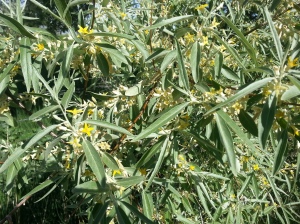
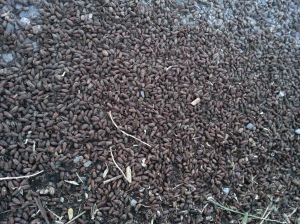



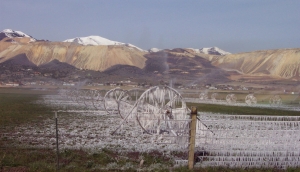


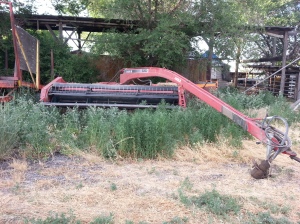




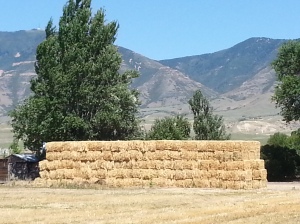





I love all your pictures
Very creative and beautiful
The pictures from previous posts are very beautiful as well
So is your writing too
LikeLiked by 1 person
Deanne. I have added several more pictures to this post to hopefully make it more enjoyable and understandable. I hope you like them.
LikeLiked by 1 person
Yeah… They are awesome… Your pictures are always unique and interesting. They definitely get my attention. Thanks for sharing Roger 🙂
LikeLiked by 1 person
Thanks so much. I’m so pleased that you enjoy them.
LikeLike
Beautifully written.
LikeLiked by 1 person
Thanks Paul.
LikeLike